30+ most popular plants for the midground of planted tanks
The midground of your aquascape is the vital link between the foreground and the background. Not only does this add body to your aquascape, but it is also valuable in screening the less attractive lower portions of the stem plants in your background. Planning the layout of your midground zone correctly will make a big difference to the maintenance of your aquascape in the long run.
Select plants that do not need constant trimming to stay at the desired height for this part of your layout. Some of the best choices for midground plants are slow-growing plants like Anubias, ferns, and moss. These plants are attached to hardscape features like driftwood or rocks, which add structure to the zone.
The following plants make great choices for the midground
- Anubias species
- Fern species
- Cryptocoryne species
- Alternanthera reineckii
- Alternanthera reineckii 'Mini'
- Staurogyne repens
- Red dwarf Hygrophila - Hygrophila 'Araguaia'
- Blyxa short leaf - Blyxa novoguineensis
- Chain Sword - Echinodorus quadricostatus
- Dwarf Cardinal plant - Lobelia cardinalis
- Downoi - Pogostemon helferi
- Lagenandra meeboldii
- Orchid lily - Barclaya longifolia
- River Buttercup - Ranunculus inundatus
- Pearlweed - Hemianthus micranthemoides
- Basil Leaf - Limnophila rugosa
- Rotala indica 'Bonsai'
- Water Hyssop - Bacopa caroliniana
- Creeping Jenny - Lysimachia nummularia
- Large Pearl grass - Micranthemum umbrosum
- Tonina fluviatilis
- Tonina 'Belem'
- Gratiola viscidula
- Didiplis diandra
- Proserpinaca palustris
- Water Violet - Hottonia palustris
- Nesaea pedicellata
- Nesaea crassicaulis
Anubias species
 Anubias Bundle - 4 Species #ad
Anubias Bundle - 4 Species #ad
- Type: epiphytic plant
- Position: attach to driftwood/stones in the midground
- Care level: easy
- Growth: slow
- Lighting: low
- CO2: low
Anubias are slow-growing, epiphytic plants that have low-light requirements. This makes them ideal plants for the midground where they can grow to an appropriate size while screening the lower stems of the plants behind them. These plants are attached to hardscape features like rocks and driftwood where they develop attractive, tangled root systems.
The large, tough leaves of this plant create great shelter for small livestock like shrimps, and algae feeders like Otos and stiphodon gobies love feeding on the algae that grow on the leaf surfaces. Anubias plants are easy to grow, tough plants that require very little maintenance.
Fern species
 Java Fern Bundle - 4 Species #ad
Java Fern Bundle - 4 Species #ad
- Type: epiphytic plant
- Position: attach to driftwood/stones in the midground
- Care level: easy
- Growth: slow
- Lighting: low
- CO2: low
Ferns like the classic Java fern make great midground plants for medium-sized aquariums. These plants have low light requirements and need very little maintenance. They tend to have a more upright growth form.
Java ferns should be attached to hardscape features, rather than rooted. One of the great advantages of this is that they can be moved around without disturbing their root systems if you wish to fine-tune your layout. Other popular varieties of Java fern include trident, windelov, needle-leaf, and narrow-leaf forms.
Cryptocoryne species
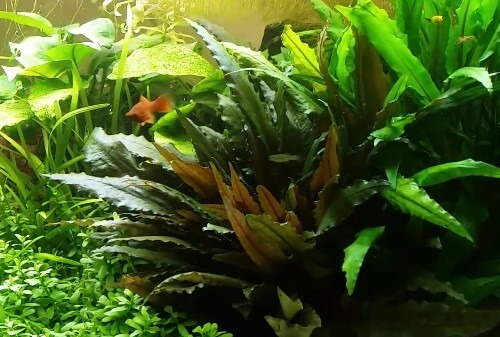 Cryptocoryne wendtii Brown #ad
Cryptocoryne wendtii Brown #ad
- Position: midground
- Care level: easy
- Growth: average
- Height: 4 – 12+ inches (10 – 30+ cm)
- Lighting: low
- CO2: low
There are over 60 Cryptocoryne species, or ‘crypts’ as they are often known, and although they all vary in size, most of the popular aquarium species make great mid-ground plants. These plants can be grown in low-light conditions and have large leaves that require very little trimming and maintenance work.
These plants come in a variety of sizes, shapes, and colors. These plants are rooted in the substrate and develop strong root systems.
Read more about this species: https://portlandaquarium.net/cryptocoryne/
Alternanthera reineckii
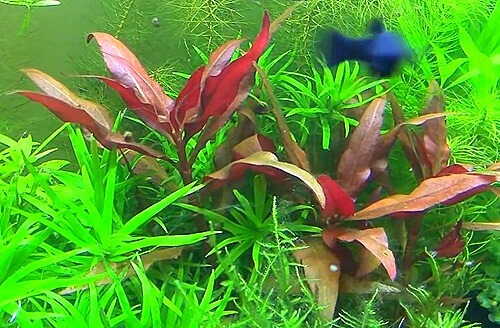
- Position: carpet, midground, background
- Care level: average
- Growth: average
- Height: 8 inches (20 cm)
- Lighting: average
- CO2: average
Alternanthera reineckii, or just AR as it is commonly known in planted tank circles, is a fantastic midground option that compliments and contrasts beautifully with finely textured green plants in the aquascape. This is a fairly slow-growing South American stem plant that will require good lighting to develop the deep red-colored foliage it is so popular for, although it will survive in low-tech aquariums.
These great-looking plants take some time to become well-rooted in the substrate and should not be moved once established. Simply trim the plant as needed, removing algae-covered leaves if necessary. This plant may be fed on and damaged by Amano shrimps.
Alternanthera reineckii ‘Mini’
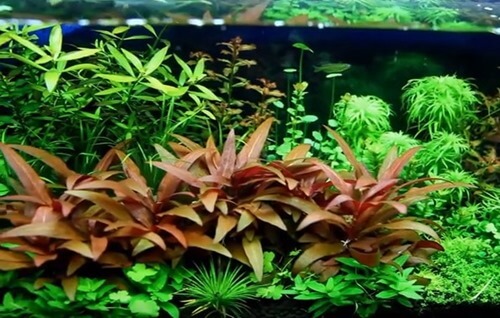 Alternanthera reineckii Mini #ad
Alternanthera reineckii Mini #ad
- Position: carpet, foreground, midground
- Care level: average
- Growth: average
- Height: 2 – 4+ inches (5 – 10+ cm)
- Lighting: average
- CO2: average
This variety of Alternanthera reineckii grows to just 3-4 inches in height, making it a great midground plant for smaller aquariums. As with the larger version, these plants will require good lighting and CO2 to produce the best leaf color and growth, but they will survive in a low-tech environment.
Staurogyne repens
- Position: carpet, foreground, midground
- Care level: easy
- Growth: average
- Height: 1.2 – 4+ inches (3 – 10+ cm)
- Lighting: low
- CO2: low
Staurogyne repens is another great South American plant that can easily be grown in low-tech planted tanks but will grow more vigorously under good lighting and with CO2. A dense, spreading growth form means these plants are often grown as carpet plants, although they also look great if allowed to grow in height.
These plants have beautiful, bright green broad leaves. To prevent spreading, grow this plant as an epiphyte by attaching it to hardscape components like rocks and driftwood in the midground of your aquarium.
Red dwarf Hygrophila – Hygrophila ‘Araguaia’
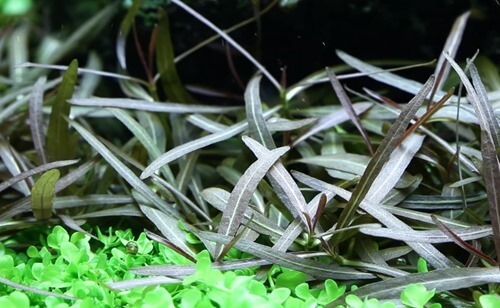
- Position: carpet, foreground
- Care level: average
- Growth: average
- Height: 4 – 8+ inches (10 – 20+ cm)
- Lighting: average
- CO2: average
This interesting South-East Asian aquatic plant has narrow red to purple leaves. It is a small species that grows best with good lighting, CO2 injection, and a good quality and fertile substrate. Being a small plant, this species is best suited for the mid-ground of small aquariums, often being grown as foreground plants in larger tanks.
Blyxa short leaf – Blyxa novoguineensis
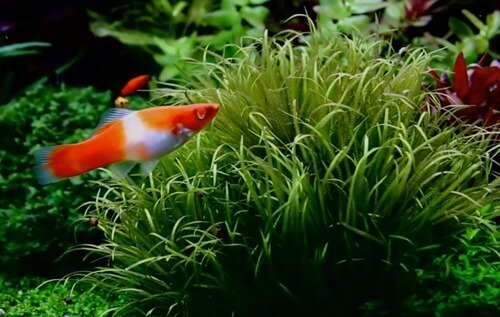
- Position: midground
- Care level: average
- Growth: average
- Height: 12+ inches (30+ cm)
- Lighting: average
- CO2: average
For aquarists looking for a unique slender-leaved mid-ground plant, this plant is highly recommended. This plant has an interesting and attractive grass-like growth form. It is a reddish-brown plant that grows as a clump and will not spread by runners.
Grow this species in tanks with strong light and nutrients for best results. Take care not to grow this plant in tanks with large leaf-nipping fish or strong currents as it has soft, delicate foliage.
Chain Sword – Echinodorus quadricostatus
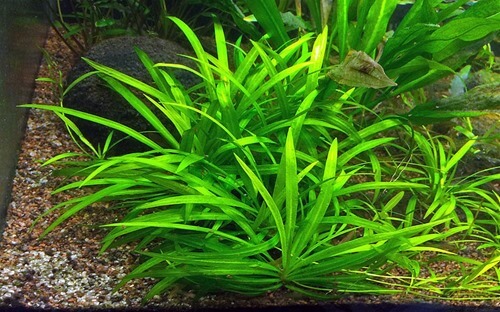
CC 3.0, Tommy Kronkvist
- Usages: high carpet, foreground, midground
- Care level: easy
- Growth: fast
- Height: 4 – 6+ inches (10 – 15+ cm)
- Lighting: low
- CO2: low
The broad-leaved chain sword is a very easy, fast-growing plant that works well in the midground of planted aquariums. These are great beginner plants that do not need strong lighting or CO2 to flourish, although they will grow more vigorously in high-tech setups.
These plants are root feeders and will require a fertile substrate to grow at their best. Be aware that this plant spreads quickly if grown in ideal conditions and will require some work to keep contained.
Dwarf Cardinal plant – Lobelia cardinalis
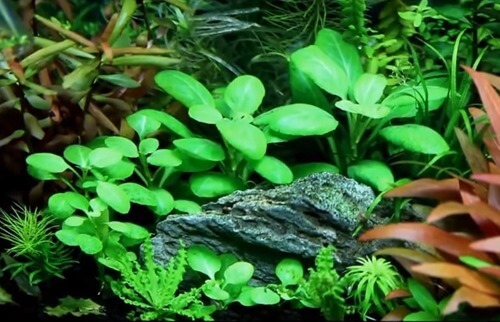
- Position: midground, groundcover
- Care level: average
- Growth: average
- Height: 4 – 12+ inches (10 – 30+ cm)
- Lighting: average
- CO2: average
Lobelia cardinalis is an interesting choice for the aquarium in that it is in fact a terrestrial plant. Experimentation has shown that this plant grows well when fully submerged and can make a great plant for the midground in planted tanks. These slow-growing plants have moderate to strong light requirements and will perform better if supplied with CO2 and a fertile substrate.
This plant looks quite different from its terrestrial form when grown fully submersed and tends to produce bright green foliage, sometimes with purple hues. Try to source plants that have been grown submersed for the best results.
Downoi – Pogostemon helferi
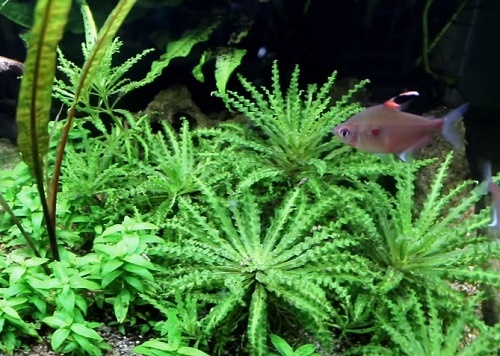
- Position: high carpet, foreground, midground
- Care level: average
- Type: stem
- Growth: average
- Height: 1.2 – 4+ inches (3 – 10+ cm)
- Lighting: average
- CO2: average
Pogostemon helferi, or Downoi as it is often called is an excellent midground plant with interesting, crinkled foliage. These plants are native to Thailand and have a more compact growth form when grown under medium to strong lighting and added CO2.
They can, however, be grown under lower light conditions where they will grow taller and leggier, as a great medium height plant for the midground. These plants are classic stem plants that can easily be grown from side shoots that are cut off and replanted.
Lagenandra meeboldii
- Position: midground
- Care level: easy
- Appearance: rosette
- Growth: slow
- Height: 4 – 8+ inches (10 – 20+ cm)
- Lighting: low
- CO2: low
Lagenandra meeboldii is a large-leaved aquatic plant native to India. These beautiful plants make a great addition to the mid-ground of planted aquariums. L. meeboldii is a slow-growing plant that grows from a rhizome. Leaf color varies according to light levels in the aquarium with plants that are grown under high lighting often taking on a reddish hue.
Orchid lily – Barclaya longifolia
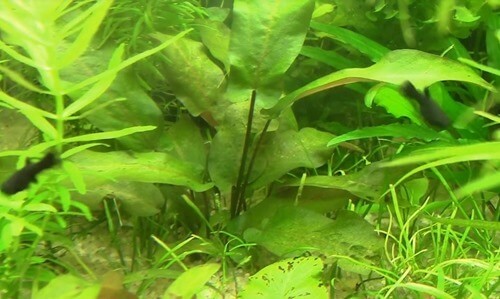
- Position: midground, background
- Care level: easy
- Growth: average
- Height: 10 – 15 inches (25 – 38 cm)
- Lighting: average
- CO2: low
Barclaya longifolia is a beautiful plant from Southeast Asia. These fascinating plants grow from a large rootstock that should not be planted under the soil. More than one plant may grow from the rootstock and the leaves they produce are beautifully colored in shades of olive to red on the upper surface, and violet below.
Snails will feed on the leaves of this demanding but eyecatching species so consider this before planting in your aquarium. These plants should be grown under bright light and in a nutrient-rich environment that has fertilizer in both the substrate and water column.
Orchid lilies undergo periods of dormancy where the leaves are shed before new stalks sprout. This dormancy typically lasts a period of a few weeks.
River Buttercup – Ranunculus inundatus
- Position: foreground, midground
- Care level: average
- Type: none
- Growth: average
- Height: 2+ inches (5+ cm)
- Lighting: average
- CO2: average
River buttercup is an excellent midground plant from Australia. This plant has a creeping growth form and grows from a rhizome. These plants are easy to grow, provided they are given medium to bright light and matching CO2.
Under moderate light, these plants grow taller stems and longer leaves, making them a great choice as a midground plant that works as a focal point in the aquascape.
Pearlweed – Hemianthus micranthemoides
- Synonym: Micranthemum micranthemoides
- Common names: pearlweed, pearl grass, baby tears
- Position: high carpet, foreground, midground
- Care level: advanced
- Growth: average
- Height: 2 – 6+ inches (5 – 15+ cm)
- Lighting: average
- CO2: average
Pearlweed is an excellent midground plant that thrives in acidic to neutral water with moderate lighting. These fine-textured plants are native to Cuba and the southeast of the USA and are easily maintained in a neat, mounded growth form by pruning the odd long shoot.
This delicate plant has small, light green leaves and works well when planted in combination with darker-leaved Cryptocoryne species.
Basil Leaf – Limnophila rugosa
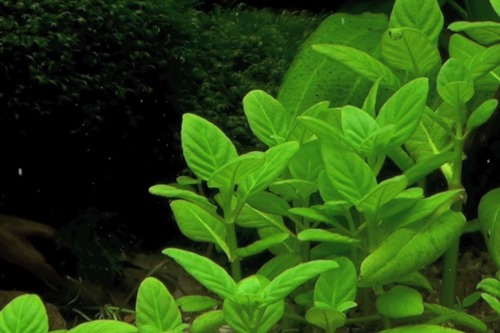
- Position: foreground, midground
- Care level: average
- Growth: average
- Height: 4 – 8 inches (10 – 20 cm)
- Lighting: average
- CO2: average
The basil-leaf limnophila is certainly an eye-catching species with large and beautifully textured, glossy green leaves. This slow-growing plant is relatively easy to care for, although it does grow better under moderate lighting with added CO2 and fertilizer. These plants look great when planted in groups in the midground of your aquascape.
Rotala indica ‘Bonsai’
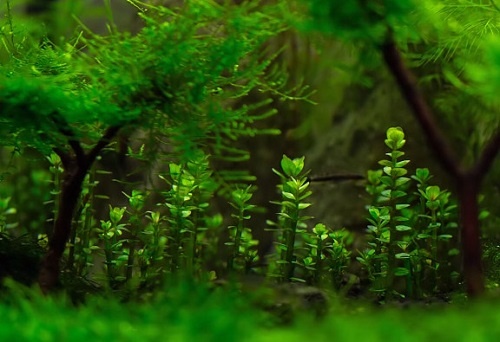
- Synonym: Ammania ‘Bonsai’, Rotala ‘Bonsai’
- Position: midground, background, nano tank
- Care level: average
- Growth: slow
- Height: 2 – 8+ inches (5 – 20+ cm)
- Lighting: average
- CO2: average
Rotala ‘Bonsai’ is a popular aquarium plant from southeast Asia. This excellent midground plant has sparsely arranged leaves on an upright stem, but if planted in clusters, will create an interesting dense form.
These plants grow best under moderate to strong lighting and may develop pink-tinged leaves on the top of the plants in ideal conditions. In bright conditions, this rotala has a relatively fast growth rate but will be slower under moderate lighting.
Water Hyssop – Bacopa caroliniana
- Care level: easy
- Growth: slow
- Height: 4 – 12+ inches (10 – 30+ cm)
- Lighting: low
- CO2: low
Bacopa caroliniana has small, bright green fleshy leaves that grow from upright stems. These plants can look a little sparse if grown on their own but create an excellent upright midground feature if planted in a group at 1-2 inch spacings. These plants are tough and easy to grow as long as decent lighting is provided and will grow at a moderate rate.
Creeping Jenny – Lysimachia nummularia
- Position: midground
- Care level: easy
- Growth: average
- Height: 4 – 8 inches (10 – 20 cm)
- Lighting: average
- CO2: low
Creeping Jenny is an ideal midground plant for coolwater aquariums up to about 72°F. These plants require strong light and a nutrient-rich substrate to grow to their full potential. This European species has medium-sized, round bright green leaves and a creeping habit that allows it to spread slowly in time.
Large Pearl grass – Micranthemum umbrosum
- Position: foreground, midground
- Care level: average
- Growth: fast
- Height: 4 – 6+ inches (10 – 15+ cm)
- Lighting: average
- CO2: average
Large pearl grass is a delicate, finely textured midground plant that is easy to grow as long as you provide it with the bright to very bright lighting it requires. Under strong lighting and with added carbon dioxide, the plants are fast growers.
This rapid growth means regular trimming might be necessary to keep it looking neat and it is often necessary to replant this species frequently as stems tend to be short-lived. These plants are native to the United States and have very small, bright green leaves and a dense growth form.
Tonina fluviatilis
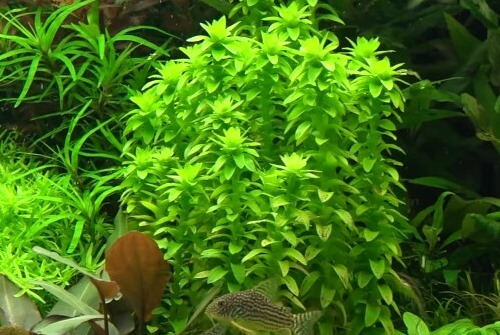
- Position: midground
- Care level: advanced
- Growth: average
- Height: 8 – 12 inches (20 – 30 cm)
- Lighting: high
- CO2: average
Tonina fluviatilis is a beautiful bright green midground plant for more experienced aquarists. These South American plants require medium to strong light, added CO2 and supplementary fertilizer in the water column in order to really shine.
Soft water is certainly beneficial to this species and growers are advised to position this plant in an area where it can receive good light from top to bottom. These upright plants look best when planted in groupings of varying heights
Tonina ‘Belem’
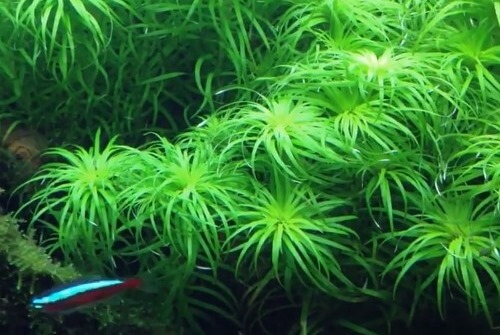
- Position: midground, background
- Care level: advanced
- Growth: average
- Height: 4 – 8 inches (10 – 20 cm)
- Lighting: high
- CO2: average
This Brazillian midground plant is a beautiful but challenging species to grow. You will need very strong lighting to ensure that this plant thrives.
Under this lighting, other aquarium plants will tend to outgrow this fairly slow-growing plant so one should ideally place it in an area with open space around it. This species requires a fertile planted aquarium substrate, added CO2 in the water column, and does not react well to unstable conditions in the tank.
Gratiola viscidula
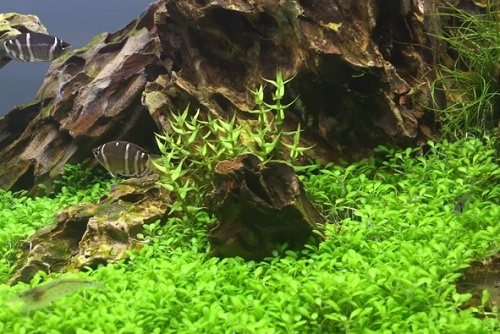
- Position: foreground, midground
- Care level: average
- Growth: slow
- Height: 1.2 – 4+ inches (3 – 10+ cm)
- Lighting: average
- CO2: average
This North American species makes a great midground plant for cool-water aquariums. It has a unique, spiny appearance and grows in flat cushion-like shapes.
Although this plant requires bright light to thrive, it is a rather delicate and slow-growing species. Provided it has sufficient light, this plant is easy to grow and can be maintained at any height by regular trimming.
Didiplis diandra
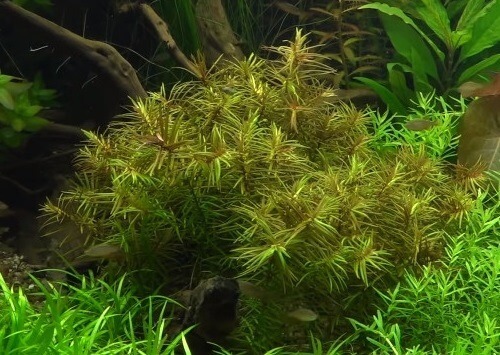
- Position: midground
- Care level: average
- Growth: fast
- Height: 4 – 6+ inches (10 – 15+ cm)
- Lighting: average
- CO2: low
This North American plant has fine, needle-like leaves that will take on a reddish color in very bright light. Unfortunately, this plant is quite demanding to grow, but experienced aquarists with excellent lighting and added CO2 may find this a rewarding midground plant.
These plants require a nutrient-rich substrate but are sensitive to chemicals in the water. The stems of this beautiful plant are very fragile so great care must be taken to when planting them and they will tend to become even more fragile if grown in insufficient light.
Proserpinaca palustris
- Position: midground, background
- Care level: average
- Growth: average
- Height: 4 – 12+ inches (10 – 30+ cm)
- Lighting: average
- CO2: average
This North American plant is a popular choice for midground plantings in tanks with medium to high lighting and added CO2. This species has attractive, serrated leaf margins and varies in color depending on the strength of the available light and the presence of iron in the system. This plant has an upright growth form and is not difficult to grow and maintain.
Water Violet – Hottonia palustris
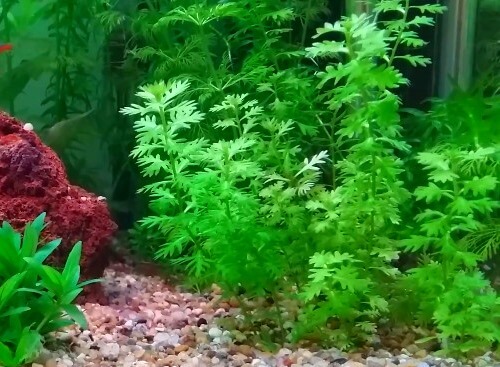
- Position: midground
- Care level: easy
- Type: stem
- Growth: average
- Height: 4 – 8+ inches (10 – 20+ cm)
- Lighting: low
- CO2: low
This Asian and European aquatic plant has medium to large feathery compound leaves. It grows from a rhizome that should be planted below the surface of the substrate.
This species makes a great fine-textured midground plant for coldwater aquariums up to about 77°F. These plants are easy to grow but require good lighting.
Nesaea pedicellata
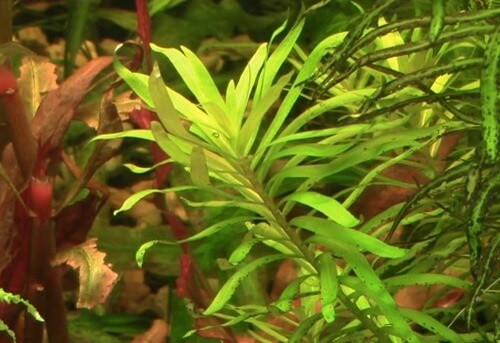
- Position: midground
- Care level: average
- Growth: average
- Height: 8 – 12+ inches (20 – 30+ cm)
- Lighting: average
- CO2: average
This East African plant is an attractive and easy to grow midground aquarium plant. A combination of yellow to dark green elongated leaves on a red stem makes this an eyecatching specimen plant. These plants grow best in moderate to high light conditions and care should be taken to keep as much of the plant exposed to light as possible to prevent damage to shaded leaves.
Nesaea crassicaulis
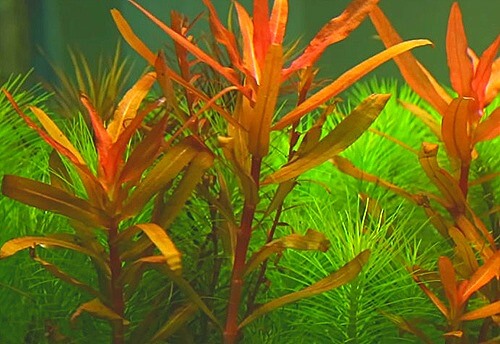
- Position: midground
- Care level: average
- Growth: average
- Height: 8 – 12+ inches (20 – 30+ cm)
- Lighting: average
- CO2: average
This Nesaea species is native to Madagascar and Central Africa. These plants require excellent lighting, added CO2, and liquid and substrate fertilizer to thrive. Although they are a rather demanding midground aquarium plant, they develop very attractive golden-red foliage if correctly grown and are a worthwhile plant for experienced aquarists.

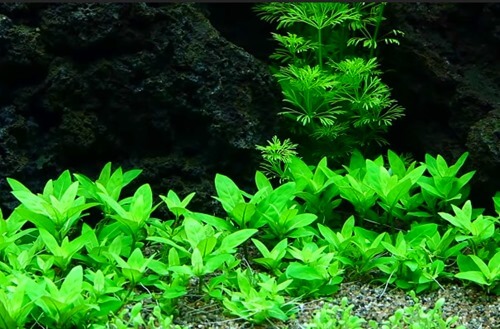 Staurogyne repens #ad
Staurogyne repens #ad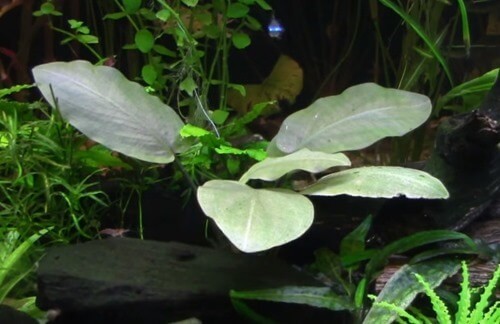 Lagenandra meeboldii #ad
Lagenandra meeboldii #ad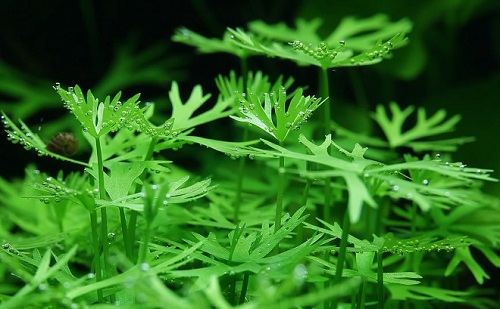 River Buttercup #ad
River Buttercup #ad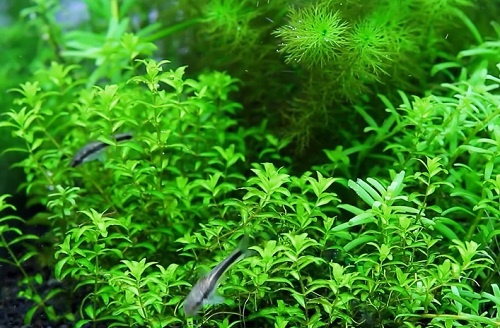 Pearlweed #ad
Pearlweed #ad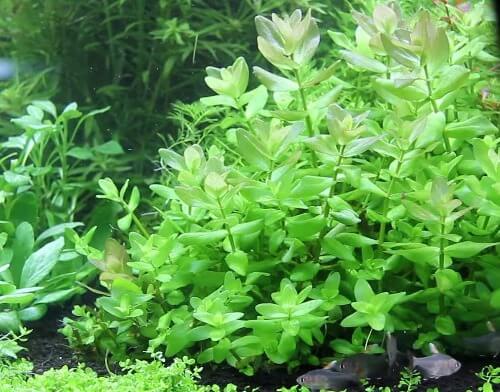 Bacopa caroliniana #ad
Bacopa caroliniana #ad Lysimachia nummularia #ad
Lysimachia nummularia #ad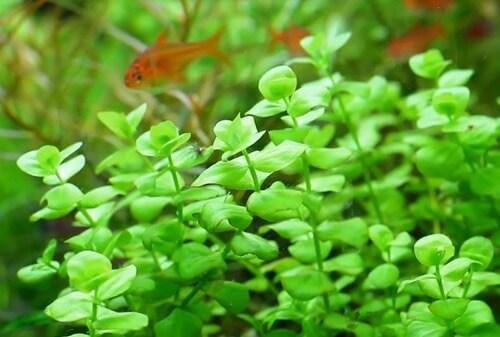 Micranthemum umbrosum #ad
Micranthemum umbrosum #ad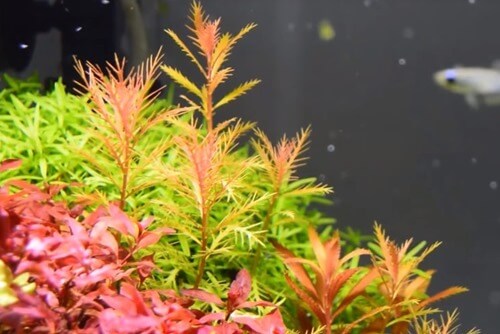 Proserpinaca palustris #ad
Proserpinaca palustris #ad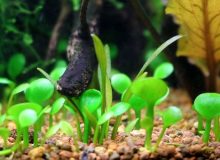
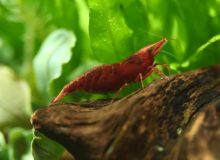
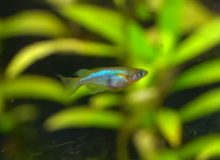
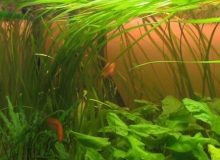
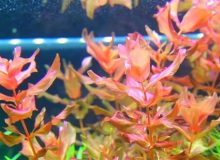
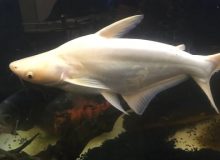
I appreciate your very helpful information.
Thanks